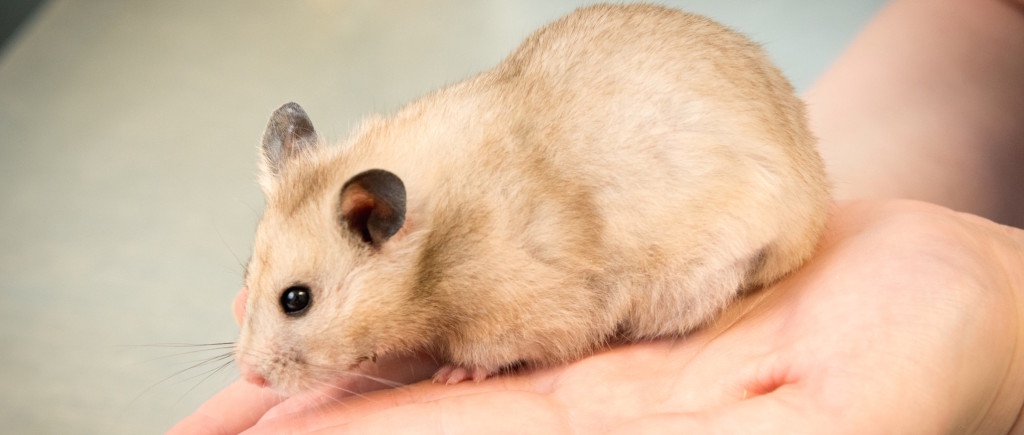
Beth a three legged hamster who still uses her wheel. She was treated at a PDSA hospital. Copyright PDSA.
The information on these pages only applies to Syrian hamsters. These are the most common pet and are easier to handle by small children than are the Russian and Chinese dwarf hamsters. Syrian hamsters (proper name Mesocricetus auratus) live alone, while the others should live in colonies.
Because Syrian hamsters are solitary animals they communicate at a distance by scent, so smell is important to them. Like any animal, Syrian hamsters need fresh water, a cage that is cleaned regularly, and properly balanced diet. They also need things to chew, areas to hide in, and warm dry bedding. It is claimed that male hamsters are more docile than females (Wolfensohn & Lloyd 2003). In the wild they lie in large burrows that can be as long as about six feet or 199 cms (Gatterman et al., 2001)
If your child is very young, always supervise its play with the pet. Children under the age of eight may harm a small animal without meaning to. That said, you can have a lot more fun with a hamster than your probably thought. It’s also an ideal pet for the housebound, as long as you realise that hamsters are nocturnal so will not be active by day. If you put your hamster cage in your bedroom, it may keep you awake at night with its activities.
We know quite a lot about hamsters, thanks to studying laboratory hamsters but some of the information hasn’t filtered through to the pet world. Hamsters need to be able to dig, burrow, climb, explore and hoard food, as they would in the wild. Scientists have discovered that they feel more optimistic if they are kept in good conditions (Bethell & Koyama 2015). Best book for pet owners is Hamsters: understanding and caring for your pet, by Anne McBride.
The better you care for your hamster, the happier it and you will be (Normando & Gelli 2011)
Helpful links can be found below the Index. If you just have a pet hamster, ignore the references in brackets. But for those that are really interested in this little animal, the references will help you learn more.
INDEX
CAGE AND EQUIPMENT FOR YOUR HAMSTER
BEST BEDDING AND LITTER FOR YOUR HAMSTER
HANDLING. HOW TO AVOID BEING BITTEN BY YOUR HAMSTER
BITING THE BARS OF THE CAGE – A SIGN OF STRESS?
KEEPING YOUR HAMSTER BUSY NOT BORED
HOW SHOULD I FEED MY HAMSTER?
HOW TO LITTER TRAIN YOUR HAMSTER?
HOW TO CHOOSE A HAMSTER
ESCAPED? HOW TO GET YOUR HAMSTER BACK
CATS AND HAMSTERS
TRAINING YOUR HAMSTER
HOW TO TELL IF YOUR HAMSTER IS IN PAIN OR ILL
OTHER SPECIES OF HAMSTERS coming later
OTHER LINKS
Towy Vale Hamstery. www.towyvale.com – Remarkably good information sheets on all hamster matters.
For safe hamster bedding made of paper or plant material not artificial fibre like nylon – http://www.petlifeonline.co.uk/?p=safebed&hi=hamster
Nice quick guide to keeping a hamster can be found here: https://ultimatepethub.com/how-to-take-care-of-a-hamster/
REFERENCES
Bethell, E. J. & Koyama, N. F. (2015), ‘Happy hamsters? Enrichment induces positive judgement bias for mildly (but not truly) ambiguous cues to reward and punishment in Mesocricetus auratus,’ Royal Society Open Science, 2, 140399.
Gattermann, R., Fritzsche,P., Neumann, K., Al-Hussein, I., Kayser, A., Abiad, M. and Yahti, R., (2001), ‘Notes on the current distribution and the ecology of wild golden hamsters (Mesocricetus auratus),’ Journal of Zoology, 254, 359-365
Normando, S. & Gelli, D. (2011), ‘Behavioral complaints and owners’ satisfaction in rabbits, mustelids, and rodents kept as pets,’ Journal of Veterinary Behavior, 6, 337-342
Wolfensohn, S. & Lloyd, M., (2003), Handbook of Laboratory Animal Management and Welfare, Third edition, Oxford, UK, Blackwell Publishing.